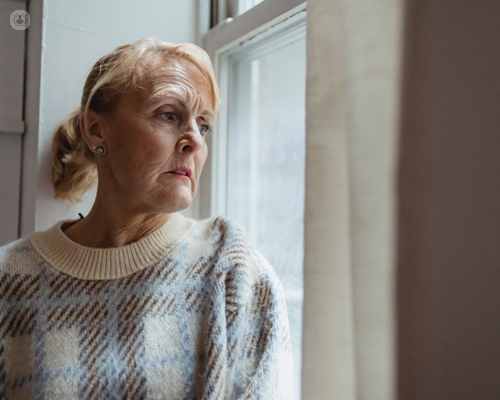Ovarian masses: Causes, symptoms and diagnosis
Autore:There are various types of ovarian masses and cysts, and here to provide a detailed insight to them and how they are treated is highly-experienced consultant in gynaecology and gynaecological oncology surgery, Mr Ahmad Sayasneh.
Learn more about the different ovarian masses that can occur, how they are treated and the statistics surrounding cases of ovarian cancer, and more, in this informative article.

What causes ovarian masses?
Ovarian masses can happen randomly to many patients. However, there are some ovarian masses in the cancer group, which are related to some genetic malformations. In particular, there is a gene called BRCA1 and BRCA2. There's the MLH1 gene, too. These ones are responsible for about ten per cent of all ovarian cancers.
However, benign ovarian masses normally happen randomly and there's no genetic background. Some of them can happen in younger women, and some of them can happen more in older women. The ones which are very well known in younger women are called the teratoma or the dermoid, and they normally happen in younger age groups, or women who are trying to get pregnant. There's the other group of benign tumours called endometriomas and these ones happen in younger women, and they are hormone dependent.
There's oestrogen; in younger women they are more likely to grow unlike in older women where there are less hormones, so some other masses can occur like serous cystadenoma, which normally don't have hormone receptors and they aren't related to menopausal stages.
What are the symptoms of ovarian masses?
They have a wide range of symptoms. They can cause no symptoms at all and they can cause very non-specific symptoms like irritable bowel symptoms, like waves between diarrhoea and constipation. They can cause tummy pain; they can cause pressure on other organs like the bladder which can cause the bladder to be overactive or have more frequent urination. They can block the urethras and cause hydronephrosis and kidney problems and no urination at all. They can block the bowels sometimes and cause bowel obstruction, and the symptoms vary between benign to malignancy. So, benign masses relate more to pain symptoms.
However, malignant masses can be related more to non-specific symptoms like:
- Bloating;
- Difficulty in eating and feeling full quickly;
- Occasionally, of course, they can cause pain.
What are the different types of ovarian masses?
Ovarian masses can be divided into five groups.
Functional ovarian masses
These are the ones that have been part of the normal, natural cycle, with a little bit of derangement. For example, ovulation is known to happen every month. Sometimes the ovulation cyst can persist and cause what we call a corpus luteum. This can get slightly bigger with haemorrhage, but it's still a functional cyst. These ones are known to disappear on their own and can take a few weeks before they disappear completely. They don't need any specific treatment.
Benign masses
These benign masses are different to the functional ones; they shouldn't be there but they occur randomly as mentioned previously, and they can cause problems if they grow bigger than five centimetres. They're very common and they can be treated differently depending on the size and depending on the symptoms.
Cancer type, which are either invasive or primary
This means the cancer's happening now and not coming from another organ, or can be metastatic. That means it can happen in another organ and metastasise to the ovaries. These cancer groups are known to metastasise either via the peritoneal surface or metastasise in the blood. These need to be treated in a cancer centre.
Borderline
A borderline is not benign and not cancer; it's in between. They don't metastasise like a cancer but they can come back if they aren't removed in the right way. They had the potential to convert into cancer over time if they aren't treated.
What is the likelihood that ovarian masses could become serious?
Most ovarian masses, luckily, are benign. It depends on age; the chance of malignancy goes up with age. In women with menopause, the chance of malignancy is higher. In women's lifetime, there's a chance of ovarian cancer. We estimate it to be about one in 70, to one in 80, in people's lifetime.
Now, one in 70 to one in 80 chances compared to one in 12 for breast cancer, for example, so it's much less. The incidence of ovarian cancer in the community is one in every 2,500 women, each year. So, compared to benign masses, this is a lot less because with benign masses there's a chance that one in 10 women will have some type of surgery because of an ovarian mass. That is much higher than the likelihood associated with malignancy.
How are ovarian masses diagnosed?
There are a few ways to diagnose ovarian masses. First, with clinical symptoms and investigations, including some blood tests. Sometimes we ask for a tumour marker to see if there's a chance these ovarian masses to be cancerous. The most famous tumour marker is CA 125.
The ultrasound scan is the golden tool of diagnosis. It characterises ovarian masses accurately in about 90 to 95 per cent. Sometimes the ultrasound scan isn't possible because we can't perform a transvaginal ultrasound scan, or the picture isn't very clear because of many different factors, like a big fibroid uterus. In that case, we can resort to an MRI.
The MRI is the second option for characterising ovarian masses after ultrasound scan because it's more difficult to get, compared to the ultrasound scan, but it gives the same accuracy as the ultrasound scan in diagnosing the ovarian mass, whether it's benign, borderline or malignant. Other tests like a CT scan are useful when we want to see how much the cancer is disseminated into the lymph nodes or into other surfaces, or into the chest.
If you’re concerned about any ovarian masses that you may have, and whether they require further treatment, arrange an appointment with leading expert Mr Sayasneh via his Top Doctors profile.


